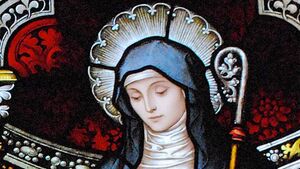Fr Pady Byrne: St Brigid of Ireland – a woman for our times

The new bank holiday has create a greater awareness of St Brigid
FEBRUARY is a time of growth and invitation for us all, when the light of spring slowly triumphs over winter darkness.
The story and celebration of St Brigid remains deeply relevant in a turbulent world. Her tolerance, compassion, kindness and inclusive spirit challenges attitudes that polarise and alienates. Brigid is an iconic female who personifies beauty and creativity. The traditional St Bridgid’s cross woven in the colour green again is a symbol of deep Christian hope. God's life brings hope and freshness, especially in the early stages of spring.
This week, we reach the midpoint of winter, marked by the cross-quarter day of Imbolc. Traditionally, Imbolc begins at sundown on the first day of February and continues through 2 February.
Imbolc is an ancient Celtic holiday celebrating the first stirrings of new life – the earliest breaths of spring. We are beginning to feel the very earliest hints of spring rising in our spirits. After months of turning inward, of hibernation and of rest, life is beginning to stir again. Spiritually, this is a time of new life coming into manifestation. We may only be seeing the tiniest hints of life above the surface, but things are really beginning to stir in the darkness.
We are about to begin a new season of promised hope and light. February is a most hopeful month. This week, we celebrate St Brigid's Day, a day which brings great hope.
St Brigid brings with her a story of compassion, generosity, healing and renewal. These early February days mark the beginning of spring. Yes, it may still feel cold, but already we see the evenings getting brighter, while emerging green shoots herald a time for new beginnings. I’m glad the darkness of winter once again is being transformed by the light of our new spring. Spring is a season of hope and renewal. We are in the true sense of Scripture called out of darkness into God’s wonderful light.
I love this time of year, a time to embrace brighter evenings and early mornings. Already there are signs of the new spring. Snowdrops, emerging from the winter soil. I'm absolutely delighted that on Monday 6 February, Ireland celebrates a national holiday attributed to an iconic and important lady – St Brigid of Kildare. I pray that this new season of hope, when green things re-emerge, will be a time of rejuvenation for us all.
Brigid was wholehearted in the ministry of helping people in need, convinced of the principle that ‘the measure you give will be the measure you get back’.
Born in at Faughart near Dundalk, Co Louth in the middle of the 5th century, probably in the latter years of St Patrick’s ministry in Ireland, Brigid refused several offers of marriage, in order to become a nun in the service of Christ and his Church. With seven other young women, she settled for a time at the foot of Croghan Hill, but moved then to the plains of the Liffey Valley where, under a large oak tree, she erected her famous convent of Cill Dara (the church of the oak – now Kildare). She died there half a century later, on 1 February 525.
The most ancient life of St Brigid is by Broccan (d. 650). Then the ‘Second Life’ was composed in the 8th century by Cogitosus, a monk of Kildare. An interesting feature of this work is his description of the Cathedral of Kildare, whose round tower may date back to the sixth or seventh century.
Brigid’s strong personality and example ensured that her community served their neighbours through various acts of mercy. Soon her small oratory at Cill Dara became a centre of religion and learning, and later developed into a big town. She founded two monastic institutions, one for men and the other for women, and apparently held jurisdiction over both of them. According to her biographer, she chose St Conleth ‘to govern the church along with herself’.
For centuries, Kildare was ruled by a double line of abbot-bishops and abbesses, the abbess of Kildare being the leader of all the convents in Ireland.
During raids by the Norsemen in the 9th century, Brigid’s relics were taken for safety to Downpatrick, where they were interred in the tomb of St Patrick and St Columcille, and since 1190 they rest in Downpatrick Cathedral. The three, Patrick, Brigid and Columcille, have for centuries been regarded as the three main patron saints of Ireland.
Even after 1,500 years, the iconic Brigid, known as Mary of the Gael, is very dear to Irish hearts, and Brigid, Breege or Bridie preponderates as a female Christian name. Hundreds of placenames in her honour are to be found all over the country, such as Kilbride, Brideswell, Tubberbride, Templebride and many more. While her main monument is in Kildare town, she is also keenly remembered in her birthplace in Co Louth. The old St Brigid’s well adjoining the ruined church there dates from antiquity and still attracts pilgrims today.
In ancient times, St Brigid’s Day became the reference point for all the seasons that followed. It dictated the ploughing, the sowing, the turning of the sod. The feast was seen as a celebration of the incarnation of Christ into the all of life: ‘In the milking of cows and the tending of the hearth, in threading the loom and gathering the peat, the breath of prayer blessing each movement, a naming of Creator upon each mindful deed.’ May we ensure the creator is at the heart of all we do and say in the name of Brigid.





